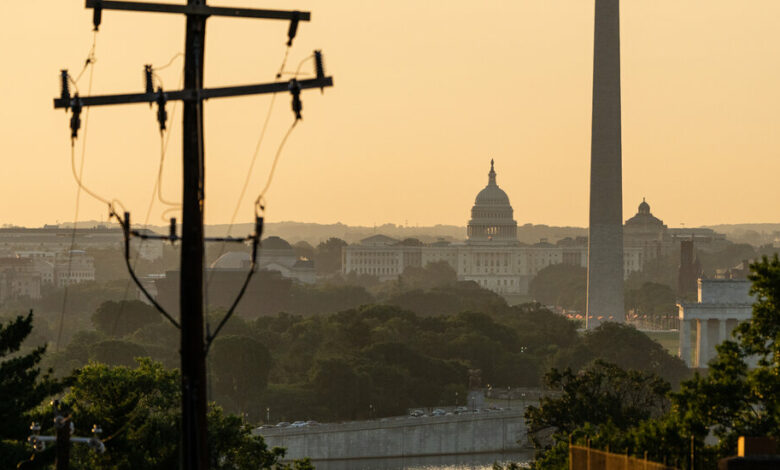The other races in 2024 with major climate interests

The political world is understandably focused on the presidential election, which is more exciting than ever as Vice President Kamala Harris gains ground on former President Donald J. Trump.
And while who occupies the White House for the next four years will have a major impact on the country’s climate policy, a topic we explored in June , many of the lower-level elections will also matter in how quickly the United States transitions away from fossil fuels. Take Arizona and Montana, for example, where elections to the commissions that regulate utilities will help determine how quickly those states embrace renewable energy.
“No matter who’s in the White House, it matters,” said Laurel Javors, associate director for state and local policy at the Sierra Club. “But a lot of climate work also comes down to local elections.”
Congress
Climate activists say who controls Congress matters most. The president can only bend the emissions curve so much without a House and Senate that can defend climate policies like the Inflation Reduction Act, which would free up trillions of dollars in clean energy investments.
With the Senate controlled by Democrats and the House of Representatives by Republicans, both with narrow majorities, the congressional elections in November will play a major role in shaping the next four years of climate action in the US.
And in some of the most closely watched races in the country, climate is an election issue.
In Pennsylvania, Dave McCormick, a former hedge fund executive who is running as a Republican and challenging Senator Bob Casey, a Democrat, made fracking a central theme of the campaignCasey is an outspoken advocate for clean energy, while Mr McCormick, who has been endorsed by Trump, has pledged to support fracking.
In Montana, Republican Tim Sheehy, a former Navy SEAL who founded an aerial firefighting company, is currently leading the polls in his challenge to Sen. Jon Tester, a Democrat. While Tester was one of the few Democrats to oppose a 2022 Securities and Exchange Commission proposal to require more climate disclosures, he is also a proponent of transitioning to renewable energy. Sheehy, meanwhile, has attacked what he calls the “climate cult” and warned that climate action would destroy jobs.
And in the House, there are dozens of competitive races. “The House is on a knife edge,” Javors said. A few seats flip, Javors said, and the House is “back to having pro-climate leadership.”
If Democrats can retain control of the Senate, no easy feat, and win a handful of those seats in the House, they could control both chambers of Congress. Should Harris also win, they could pursue ambitious climate policies at the federal level.
State legislators
One measure of the importance of local action is the number of Americans living in states that are committed to 100 percent clean energy. That figure was just 1 percent of the country’s population in 2017; today it’s 40 percent, a change that was driven by state legislatures and governors, not the White House. There are now 24 states, plus the District of Columbia and Puerto Ricowith targets for 100 percent clean energy.
“It drives investment, it drives research and development, and it gets results,” said Pete Maysmith, senior vice president of campaigns for the League of Conservation Voters. “It takes dirty, polluting fossil fuels off the grid and puts clean, renewable energy on the grid.”
One of the most recent states to make such a commitment is Minnesota, where the bill was signed into law by Governor Tim Walz, who is now running with Harris for vice president.
Control of the legislatures of several swing states, including Arizona, Michigan, Minnesota, New Hampshire and Pennsylvania, is to grab in november.
Governors
In many states, climate action is largely driven by the legislature. But in some states, governors can use their executive power to advance their priorities. One such state is North Carolina, where Gov. Roy Cooper bypassed a Republican legislature to promote offshore wind development, direct state agencies to work together to combat climate change and encourage electric vehicle adoption.
Cooper, who will be interviewed during our live Climate Forward event on September 25, is term-limited and cannot seek re-election. But the two men in a neck-and-neck race to replace him are in stark contrast with their views on climate issues.
Republican Lt. Gov. Mark Robinson has called climate change a hoax and promised to double down on fossil fuels. Democrat Attorney General Josh Stein has sued polluters and suggested he would continue Cooper’s strategy of executive action to address climate problems.
Ten other states will elect their governors in November, but none of the races are as close as North Carolina’s.
Committees
Then there are the local agencies that regulate energy production. In at least two key states, control of those commissions is up for grabs.
The Arizona Corporation Commission, which sets minimum clean energy requirements for utilities, is currently controlled by Republicans who have not made efforts to expand solar energy in the state and renewable standards postponeddespite abundant sunlight. But six candidates are vying for three open seats, and if Democrats gain control of the commission, it could lead to a significant shift in the state’s energy policy.
In Montana, a nearly identical dynamic is playing out in the battle for a seat on the Public Service Commission, which regulates the state’s utilities.
With Democrats surging in the polls, the Sierra Club’s Javors believes the momentum from the Harris-Walz campaign could have positive implications for climate issues in other elections as well.
“The top of the ticket always gets turnout,” Javors said. “We expect a lot of momentum on climate issues.”
Extreme heat forces schools to close, threatening global progress in education
The continued burning of fossil fuels is keeping schools around the world closed for days, sometimes weeks, and is threatening to undermine one of the greatest global achievements of the past decades: education for children.
Consider the magnitude of some of the recent school closures.
Pakistan closed schools for half of its students, or 26 million children, for an entire week in May, when temperatures were expected to soar to more than 40 degrees Celsius, or about 104 Fahrenheit. Bangladesh closed schools for half of its students during a heat wave in April, affecting 33 million children. So did South Sudan in April. The Philippines ordered school closures for two days when heat reached what the country’s meteorological agency called “dangerous” levels.
And in the United States, hot days forced schools in districts from Massachusetts to Colorado to close or go home early this past school year. — Somini Sengupta. Read more.




